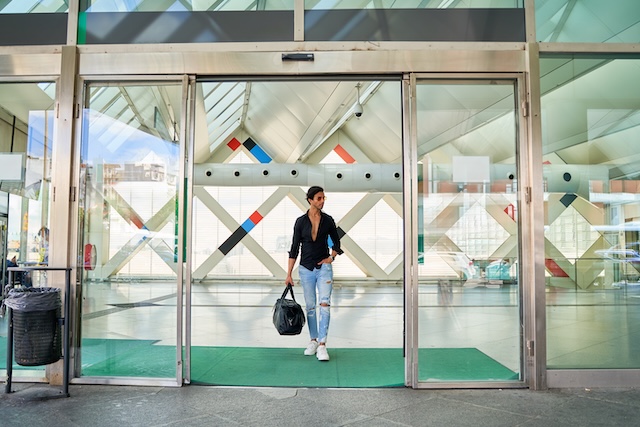Table of Contents
What to Look for in Modern Automatic Sliding Door Systems
At a Glance
Applications & Design Overview
Triggering & Activation Methods
Key Components: Operators, Sensors & Control Systems
Standards, Regulations & Compliance
Energy Efficiency & Thermal Performance
Maintenance & Longevity
Doorway Services Helps Businesses Choose the Right Automatic Door Systems
At a Glance
Choosing the right automatic sliding door for your commercial property involves focusing on compliance, durability, and long-term performance. In this guide, we explain how automatic sliding doors work, what design and sensor options you should consider, and how to avoid common problems.
When you’re building your own commercial complex, choosing automatic sliding doors is one of the key decisions you’ll make. The system you choose has to cope with constant use, comply with safety regulations, and match the aesthetics of your building.
Choose the wrong automatic sliding door, and you could end up with an overpriced door no one uses or a cheap one that fails under heavy traffic, neither of which is ideal.
At Doorway Services, we’ve helped hundreds of businesses extend the life of their commercial door systems through maintenance and repair. Contact us for a consultation if you need guidance on how to pick a sliding door. In this guide, we’ll expand on how automatic sliding doors work and the things you should keep in mind when you’re choosing one for your commercial building.
Applications & Design Overview
Automatic sliding doors are highly convenient for office buildings, hospitals, and supermarkets, making entrances more accessible without needing a lot of clearance space.
The design you pick for your commercial automatic sliding doors largely depends on the space you have. We recommend a single sliding panel for smaller entrances and bi-parting or telescopic doors for wider areas.
When it comes to the material of the door, you’ve got a few choices, including a glass finish or an aluminium frame if you need something that supports insulation and extra durability.
Triggering & Activation Methods
There are a couple of triggering and activation options offered with commercial automatic sliding doors. The first is where the door relies on sensors and opens automatically when someone is approaching, then closes behind you. Some systems also offer touchless wall switches, which are a good fit for areas where hygiene is important, like healthcare or food preparation.
Remote operation is becoming more common too, allowing doors to be opened or locked with an app or a handheld device.
The right activation method for you should be based on factors like whether you’d prefer something more convenient or whether you want more control over who can enter the building. Given the UK’s cold winters, how soon the door opens and shuts also becomes an important factor.
Key Components: Operators, Sensors & Control Systems
There are certain key components that can be found in every automatic sliding door.
First, there’s an operator that makes the door open and close. For sensor-based automatic doors, you also need sensors installed at key points of the entrance and exit. Knowing how to pick a sliding door involves comparing these components to make your choice easier.
You should also look for manual overrides in the case of power outages or fire alarms. Some automatic doors offer modular control systems, which means you can add extra features later.
Standards, Regulations & Compliance
In the UK, commercial automatic sliding doors need to meet certain regulatory requirements to be safe for the public. If you’re wondering how to pick a sliding door, you’ll want to take the BS EN 16005, Building Regulations Part M, and the Disability Discrimination Act into account.
If you’re upgrading your older doors, make sure they meet current standards. A professional installer can help you achieve this.
Energy Efficiency & Thermal Performance
An automatic sliding door has a lot of impact on your building’s energy efficiency. To maintain a building’s existing energy efficiency and thermal performance, doors that open frequently should also have features like air curtains or vestibules. Some minor sliding door details like insulated glass, tight seals, and energy-efficient motors also contribute to energy efficiency.
Additionally, make sure you specify to the installer that you’re looking for energy efficiency, and they’ll help you find the right mix of features for your commercial building.
Maintenance & Longevity
An automatic sliding door works hard every day, and to keep it in good working order for as long as possible, you need to conduct regular maintenance.
Basic maintenance involves cleaning the tracks, checking seals, and lubricating the moving parts. If you’re having problems with your automatic doors, get them checked by the professionals at Doorway Services instead of letting the issue get worse.
Without proper maintenance, smaller problems like noisy rollers, misaligned tracks, or slow responses can become bigger issues.
Doorway Services Helps Businesses Choose the Right Automatic Door Systems
We hope you now have the information to know how to pick a sliding door for your new commercial property.
Even the best sliding doors need regular maintenance to prevent common sliding door problems, and that’s where Doorway Services is here to help. We’ve worked with all types of commercial doors, including manual, automatic, and sliding doors. We can help you maintain your existing doors while prioritising safety, security, and compliance with minimum downtime.
Whether you’re looking for annual maintenance, a one-off repair, or a new door installation, we’re happy to help. Connect with us today to learn more about our services.


Recent Comments